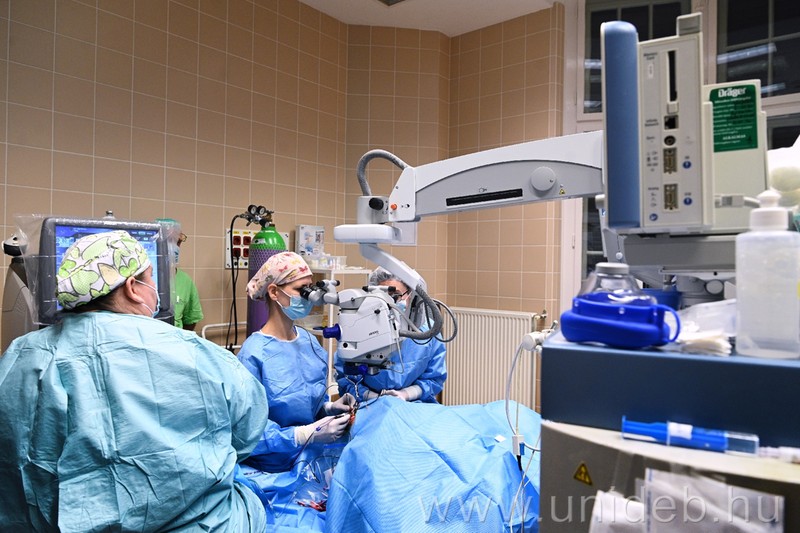For the first time in Hungary, the Ophthalmology Clinic of the University of Debrecen introduced the procedure by which choroidal melanoma can be treated by retaining the eyeball. First, the tumor is destroyed with imaging control and precision external irradiation, and then the retina surgeon removes the tumor tissue from inside the eyeball. The treatment requires the close cooperation of the Oncoradiology Clinic, the Medical Imaging Clinic and the Ophthalmology Clinic.
The most common malignant tumor of the eye is melanoma of the choroid. In Hungary, the Ophthalmology Clinic of the University of Debrecen Clinical Center has already been a national center for the diagnosis and care of these tumors. Nationally, it was and still is possible to treat choroidal melanoma with applicators containing the beta-radiating isotope Ruthenium-106, so-called near-irradiation, while retaining the eyeball.
The new, complex treatment, which requires targeted radiosurgery and special surgery, was first performed in December last year at the Ophthalmology Clinic of the Clinical Center of the University of Debrecen. In the week before the operation, the radiosurgery intervention takes place after special imaging and planning.
– First, we destroy the tumor with external radiation. After the CT and MR examination necessary for planning, the radiation therapist and the physicist plan with the help of a computer program how the linear accelerator can most ideally deliver the appropriate radiation dose so that the tumor tissue is destroyed, but the surrounding tissues receive the least possible radiation exposure. Since the cell death would cause an inflammatory reaction to such an extent that it would practically destroy the eyeball itself, to avoid this, the retina surgeon removes the tumor tissue from the inside of the eyeball the day after the radiation treatment – explained Mariann Fodor, director of the Ophthalmology Clinic.
During retinal surgery, the tumor tissue originating from the choroid is removed together with the overlying nerve membrane (retina).
These tumors are about fifteen millimeters in diameter, while the diameter of the entire eyeball is about twenty-four millimeters, i.e. compared to the eye, a rather large deficit is created on the retina and the choroid. Under these conditions, it is quite a challenge to reattach a nerve membrane that has been completely detached as a result of the tumor and radiation treatment in such a way that it remains permanently in place. Although radiation applied before surgery significantly reduces the incidence of bleeding, the removal of a tissue growth always involves bleeding, which worsens visibility during surgery. We try to avoid this by keeping the blood pressure low during anesthesia and by raising the intraocular pressure during the operation
– said the clinic director.
The surgery is performed to avoid removing the eyeball, primarily so that the patient does not have to wear a prosthesis. The intervention requires serious expertise in retina surgery.
This intervention was initially carried out without radiation around the world, but they realized that due to the small size of the eyeball, the safety zone used for tumor removal is very small, which is why they often experienced the recurrence of tumors after the operations. Without irradiation, such an operation has already been performed in Hungary with a very small number of cases. Today, this type of surgery is recommended to be performed in combination with radiation. This combined form was first introduced in Hungary at the Ophthalmology Clinic of the Clinical Center of the University of Debrecen in December 2023, with the aim that as few patients as possible have to experience the loss of an eyeball in the future
– stressed Mariann Fodor.
The introduced combined therapy is complicated and requires complex organization between the clinics, therefore the therapeutic steps are carried out by the director of the Medical Imaging Clinic, Professor Ervin Berényi, the head of the Department of Oncoradiology, Professor Árpád Kovács, and the director of the Ophthalmology Clinic, associate professor Mariann Fodor of the Ophthalmology Clinic’s intraocular tumor referral with the participation of its leader, clinical specialist Éva Surányi. Eye-sparing, combined therapy for large, opposite tumors is supported by the Ophthalmology department of the Professional College.
To learn radiation therapy and eye surgery, the specialists took part in a study trip in the fall of 2023 at the University of Essen, where about two-thirds of the tumors in Germany are treated.
(unideb.hu)


















